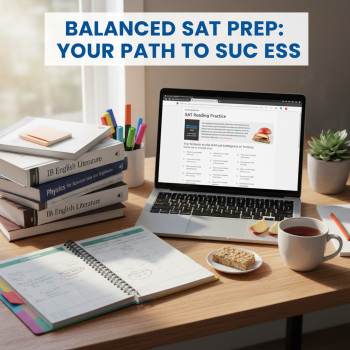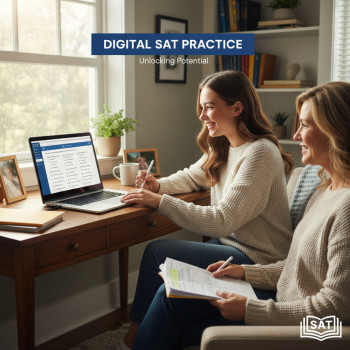Why Balance Matters: The Secret Ingredient in Digital SAT Success
When you picture SAT prep, what do you see? Furiously flipping through practice questions at 2 a.m., cramming an entire math section in one marathon session, or hovering over a screen for hours until your eyes burn? If that’s your image, you’re not alone. Many students try to out-prepare stress with more hours. But there’s a better approach: balance. A well-rounded daily routine—one that blends focused study, consistent sleep, movement, reflection, and time for hobbies—not only preserves your sanity but actually raises the quality of your learning. For the Digital SAT, where test format and stamina play a role, balance is especially powerful.
The difference between quantity and quality
Studying longer doesn’t always mean studying better. Intentional, varied practice creates stronger neural connections than repetitive, unfocused hours. Think of studying as training a muscle: lifting heavy for a few sets with good form is more effective than endlessly curling poor-form reps. On the Digital SAT, this translates to targeted practice on adaptive-style question sets, timed sections on Bluebook, and deliberate review of mistakes—done in shorter, focused sessions rather than marathon grind-sessions.
How balance directly impacts SAT performance
Here are the core ways a balanced daily routine tangibly improves your Digital SAT outcomes:
- Better memory consolidation: Sleep and spaced repetition help transform short-term learning into long-term recall—crucial for formulas, vocabulary, and test strategies.
- Improved focus: Short, distraction-free study bursts (like Pomodoro intervals) maintain high attention, leading to more correct answers in less time.
- Reduced anxiety: Routine and predictability calm nerves. When your body knows when to study and when to rest, acute test fear diminishes.
- Higher stamina: Balanced routines build the mental endurance needed to sit through a digital testing session without performance dips.
- Fewer mistakes from fatigue: Movement, hydration, and proper breaks lower careless errors—especially on time-pressured math and evidence questions.
Digital-specific considerations
The Digital SAT runs on devices through the Bluebook app and tests things slightly differently than the paper format. Managing screen time, integrating practice on the same platform, and getting used to the pacing are all part of preparing smartly. Balance helps you stay fresh during screen-based practice and makes transitions on test day smoother.
Designing a balanced daily routine: practical blueprint
Below is a flexible template you can adapt to your life. The idea is to create reliable structure while leaving room for adjustments—because rigid plans break down quickly.
Core daily blocks (sample 12-hour day)
This schedule assumes school or classes occupy part of your day; tailor the timing to your life. The focus is on repetition and sustainable effort.
| Block | Duration | Purpose | Example Activities |
|---|---|---|---|
| Morning reset | 30–60 min | Wake-up routine to prime the brain | Light exercise, breakfast, quick review of tough flashcards |
| Focused study 1 | 45–60 min | High-priority practice (math or evidence) | Timed practice set, targeted problem review |
| School / commitments | Varies | Daily life and classes | Classroom learning, apps, homework |
| Active break | 20–30 min | Clear the mind and move | Walk, short workout, snack |
| Focused study 2 | 45–60 min | Secondary practice block (reading/writing) | Reading passages, annotating, grammar drills |
| Deliberate review | 20–30 min | Reflect on errors and make notes | Error logs, spaced repetition tasks |
| Relaxation / hobbies | 1–2 hours | Recharge emotionally | Friends, music, creative work, downtime |
| Evening wind-down | 30–60 min | Improve sleep quality | Light reading, put devices away, prep for next day |
This blueprint is a starting point. The point is consistency: shorter blocks of high-quality work beat long, inconsistent sessions.
Weekly rhythm: mixing intensity and recovery
Your week should combine intense, focused practice days with lighter review days. A suggested cycle might look like this:
- 3 days of intensive practice (timed sections, full-length practice on Bluebook once a week)
- 2 days of skills-focused work (vocab, grammar rules, typical misconceived math concepts)
- 1 lighter day (review notes, skim flashcards, low-pressure reading)
- 1 full rest day (social time, hobbies, mental reset)
Specific balanced strategies that actually move the score needle
Here are concrete tactics you can implement tomorrow that combine balance with evidence-based learning.
1. The 45/15 focused cycle
Study for 45 minutes, then take a 15-minute break. During study, remove distractions—phone on Do Not Disturb, notifications off. In the break, move your body, hydrate, and do something unrelated to test material. This rhythm keeps cognitive energy high.
2. One quality full-length practice every 7–10 days
Doing a true full-length practice test every week or every ten days builds test stamina and simulates conditions you’ll face in Bluebook. After the test, spend two sessions on analysis: one for content errors and one for timing and strategy errors.
3. Prioritize sleep like the unsung study tool
Memory consolidation happens during sleep. Pulling an all-nighter before a practice test or the real test backfires. Aim for consistent sleep windows: same bedtime and wake time, even on weekends when possible. Good sleep makes recall faster and reduces careless mistakes.
4. Integrate movement and nutrition
Short high-intensity intervals or a brisk walk before study sessions increase alertness. Keep protein and complex carbs on test day for steady energy—sugary snacks cause spikes and crashes that undermine focus during long sections.
5. Use the error log religiously
Keep a running log of every missed question with: the concept, why you missed it, and the correction. Review the log during your morning reset and weekly review. This turns mistakes into tailored mini-lessons.
How to know if your routine is balanced (signs to watch for)
Balance isn’t a vague ideal—it shows up in measurable ways. Look for these signs to know you’re on the right track:
- You can finish timed sections with a few minutes to spare without frantic guessing.
- Your error types change from careless or fatigue-related to concept-related—meaning you’re pushing into deliberate practice.
- You aren’t sick of studying: you can keep to the plan for multiple weeks.
- Your full-length practice scores show gradual upward trends, with fewer large dips.
Sample balanced study week (two-week block example)
This two-week plan blends intensity, targeted practice, and recovery. Adjust the hours to fit school or activities.
| Day | Focus | Key Activities |
|---|---|---|
| Monday | Math concepts | 45/15 cycles on algebraic manipulation, practice problems, error log update |
| Tuesday | Reading & Evidence | Timed passages, annotation practice, passage mapping |
| Wednesday | Mixed practice | Short adaptive practice set on Bluebook; review timing |
| Thursday | Writing & Language | Grammar drills, sentence-level practice, build error bank |
| Friday | Full-length practice | Simulate test day: Bluebook practice, timing, break routine, post-test analysis |
| Saturday | Reflection & light review | Revisit error log, flashcards, light reading |
| Sunday | Rest & recharge | Hobbies, social time, no heavy study |
Real-world examples: what balance looks like for different students
Not every schedule looks the same—balance means something slightly different for each student. Here are three brief snapshots to spark ideas.
The busy student-athlete
Constraint: practice and competitions eat large chunks of afternoons. Strategy: use morning 30–45 minute focused sessions before school for vocabulary and formula review; two 45-minute sessions on light academic days; full-length test on a weekend with careful sleep planning. Movement needs are already covered; nutrition focuses on steady carbs before games and practice.
The part-time job student
Constraint: evening shifts. Strategy: shift the main study block to late morning when energy is higher, then a second shorter block after work for review. Keep Sunday sacred as a full rest day. Error logs and short Bluebook practices on commute (if safe) can maximize time.
The straight-to-the-point scorer
Constraint: limited study time but high efficiency. Strategy: daily 45-minute focused cycles targeting weakest areas, one weekly full-length test, and deliberate review notes. Use high-quality practice material and consider occasional 1-on-1 sessions for targeted feedback.
When to bring in extra help—and how balance makes it more effective
Some students hit plateaus despite disciplined routines. That’s a normal part of deliberate practice. What changes the game is expert feedback—someone who can identify stubborn patterns and give precise fixes. This is where personalized tutoring shines.
Imagine you’ve been missing the same kind of algebra problem repeatedly. A tutor can spot not only the content gap but also a timing or strategy issue: maybe you’re rushing through the setup step. With 1-on-1 guidance, tailored study plans, and AI-driven insights that highlight patterns across practice sets, you spend less time guessing and more time improving. Sparkl’s personalized tutoring approach—one-on-one attention, tailored study plans, and data-informed insights—fits naturally into a balanced routine by focusing your limited study time on the high-leverage moves that yield real score gains.
How to integrate tutoring into your routine
- Schedule tutoring sessions during your high-energy study blocks so you arrive alert and ready to act on feedback.
- Bring specific error log entries to the session—this makes the time hyper-focused and productive.
- Use tutoring to plan the next week: what to intensify, what to rest, and what to test.
Practical tools and habits to keep your balance steady
These small, repeatable habits support sustainability and reduce friction so balance becomes automatic.
- Checklist before each study session: phone silenced, water nearby, error log open, clear objective for the session.
- Weekly review ritual: 30 minutes to scan errors, note trends, and set three priorities for next week.
- Sleep alarm strategy: set a bedtime reminder and a phone-free buffer for 30–60 minutes before bed to improve sleep quality.
- Device practice: use the Bluebook app for at least some of your timed practice so device-specific navigation becomes second nature.
- Accountability: pair up with a study buddy or check in with a tutor weekly to keep the plan honest.
Common myths about balance and why they’re misleading
Balancing study and life is often framed as a luxury rather than a strategy. Let’s bust a few myths.
Myth: “More hours always mean higher scores.”
Reality: Without focused practice and feedback, extra hours can reinforce mistakes. Quality beats quantity.
Myth: “Rest days are wasted time.”
Reality: Recovery prevents burnout and preserves cognitive performance. Rest is an investment in future learning.
Myth: “All study time should be on test-like questions.”
Reality: Skills work—vocabulary, grammar rules, and targeted concept reviews—are essential complements to full-length practice; they prevent repeated errors.
Putting it all together: a two-week sprint you can start today
Want a concrete plan you can begin right now? Here’s a focused two-week sprint that balances intensity with recovery:
- Week 1: Three focused practice days (math, reading, writing), one full-length practice on the weekend, two light review days, one rest day.
- Week 2: Shift priority to your weakest section from Week 1 and integrate one tutoring session to adjust your study plan. Keep one full-length practice at week’s end and a restorative day before repeating the cycle.
After each full-length practice, spend 2–3 sessions analyzing mistakes and updating your error log. If you’re using personalized tutoring, bring the test and the error log to your tutor so you can build the next tailored plan together—this is how small, steady improvements stack into big score gains.
Final thoughts: balance is not a compromise—it’s strategy
Preparing for the Digital SAT doesn’t have to be a tale of stress and sacrifice. When you design a balanced routine—one that includes focused study, sleep, movement, reflection, and enjoyable downtime—you build a system that sustains effort, sharpens focus, and protects your well-being. Balance helps you learn smarter, not just harder.
If you ever feel stuck or want to accelerate progress, consider adding personalized support—targeted 1-on-1 tutoring, tailored study plans, and data-driven insights can turn weeks of guesswork into precise, high-impact practice. Small, consistent habits and occasional expert guidance are the pair that unlock measurable improvements.
Start small: pick one element from this article to change tomorrow—sleep 30 minutes earlier, add a 45/15 study cycle, or log three recent mistakes. Tiny shifts carried out consistently will change your trajectory more than a last-minute cram ever could. Balance is not about doing less; it’s about doing the right things in the right rhythm.
Good luck, and remember: steady, balanced preparation positions you to walk into test day calm, confident, and ready to do your best.














No Comments
Leave a comment Cancel